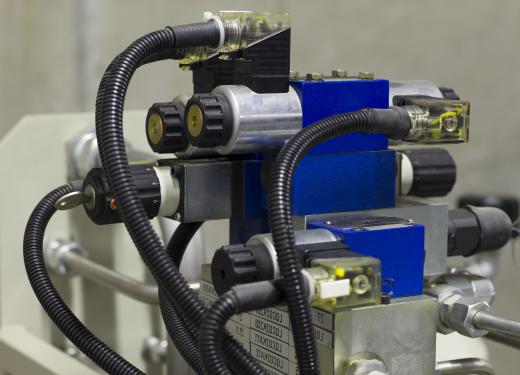A valve assembly is a complete valve mechanism including all peripheral devices directly related to the installation and functioning of the valve. The term may be applied to all valve types, including gas or fluid flow control valves and internal combustion engine valves. A valve assembly typically includes the entire fluid control mechanism and its casing, electrical or mechanical actuation mechanisms, and any related connectors, external sensors, and fasteners. In some cases, valve assemblies are supplied with ancillary devices, such as mounting adapter sets, shim selections, and spare seals.
In fluid and gas system flow terms, a valve is understood to be any mechanical device used to stop, start, or throttle a flow of fluid or gas through a system. In this sense, "throttle" refers to the act of controlling the extent of the flow. In these applications, "valve assembly" is a collective term used to describe the entire valve mechanism and all parts that play a direct, physical role in its actuation, operation, and control during operation. Valve assemblies are generally purchased complete to ease the process of replacement, but may, in the case of larger valves, be ordered on a part-for-part basis to reduce costs.

The main component in any valve assembly is the fluid or gas control mechanism and its casing where relevant. In some applications, this may be as simple an entity as an internal combustion engine valve, while, in others such as gate, ball, or butterfly types, a complex arrangement of parts encased in a external casing known as the valve body. In the case of a manually-actuated valve, the actuation mechanism will usually be an integral part of the main valve body. If the valve is automated, the second component in the assembly will be the actuator. This may be an electric motor, hydraulic or pneumatic unit, or a solenoid, along with all related hose or electric connections and cables.
Depending on the nature of the application, the valve assembly may also include external controllers such as stop/start stations and travel limit sensors. Valve specific fasteners such as grub screws, bolts, and circlips will also be included in the valve assembly description. Any ancillary equipment necessary for the installation and operation of the valve such as thread and flange adapters would also be considered to be part of the valve assembly and are often supplied as standard accessories. In the case of tappet-type valves, sets of valve shims may also be included. These peripherals will often also include replacement parts for high-wear parts of either the internal or external mechanisms, including spare O-rings, bushes, or seal elements.
